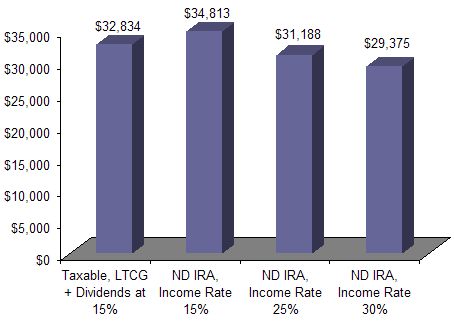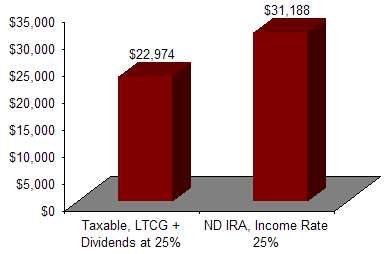Continued from Part 1: Future Roth IRA Rollover. Now we’ll consider what happens if we don’t convert to a Roth.
To recap, an non-deductible IRA everything is the same as a Traditional IRA except that the initial contribution is not tax-deductible. This means that it grows tax free, but all earnings (dividends + capital gains) are taxed as ordinary income upon withdrawal. The original contribution isn’t taxed again.
This is in contrast to regular taxable account, where you can defer taxes on capital gains until you sell. Currently, if you hold stocks or bonds for at least a year before selling, you’ll be taxed at the long-term capital gains (LTCG) rate of 15% or less. Qualified dividends are taxed when received, but are also currently taxed 15% or less. Non-qualified dividends such as from bonds or REITs are taxed as ordinary income.
So which one’s better? I decided to run a few sample scenarios to find out. Here is the IRA scenario spreadsheet I used, which you can play with as well. I’ll be assuming that current tax rules stay the same when you withdraw, which is almost guaranteed not to be the case, but hopefully we’ll get something out of it.
Assumptions
Initial Balance: $4,000 after-tax
Ordinary income tax rate: 25%
Dividend tax rate: 15%
Time Horizon: Lump-sum withdrawal after 30 years
Scenario #1: Buy-and-Hold With Stock Index Funds
Let’s say you invest in an S&P 500 index fund, with very low turnover. You buy and hold until withdrawal. Total annual return is 8%, with 2% being in dividends each year. With a non-deductible IRA, it keeps growing as gets taxed at the end. After 30 years, you’ll end up with $31,188.
With a taxable account, you’ll get taxed 15% on those dividends every year, but the rest is accumulated as long-term capital gains. Upon selling it and paying 15% on those gains, you end up with $32,834. Taxable wins by $1,646 (5%).
If you lower the ordinary tax rate to 15%, then the non-deductible IRA wins by $1,979 ($34,813 vs. $32,834). If you raise your ordinary tax rate to 30%, then the taxable account wins loses by $3459 ($29,375 vs. $32,834). In general, taxable wins out when your tax rate at withdrawal is about 21%.

Scenario #2: Active Trading With Stocks or Stock Funds
Now if you have lots of buying and selling in your portfolio, then you’ll be subject to short-term capital gains every year. Here, if you assume 100% turnover (holding stocks for just under a year) and you still earn 8% annually, taxable will never win regardless of ordinary tax rates. Even at 9% return in taxable vs. 8% return in IRA. The yearly drag of taxes kills your returns, so you should probably seek the shelter of a IRA if you plan on investing in moderate-to-high turnover funds.
Scenario #3: Buy-and-Hold With Bonds or REIT Funds
Holding a bond fund or REIT (real estate) fund is actually similar to Scenario #2, because most of the earnings from bonds and REITs are due to their interest yield or dividend distributions, and those are taxed at the higher ordinary income rates.
Let’s say you have an REIT fund that also gains 8% annually, and 100% of it’s gains are in the form of unqualified dividends. (REITs have a historical average yield of about 6-8%)
At 25% income tax rates, the taxable account just can’t keep up with an final value of $22,974 vs. $31,188 from the non-deductible IRA. That’s a 35% increase in value by going with the IRA. As income tax rate rises, the IRA’s advantage increases. A similar result occurs for bonds, although the difference is smaller due to lower expected returns.

Liquidity or Early Withdrawal Concerns
A significant advantage of taxable accounts is that you can choose to access, or not access, the funds at any time. With an IRA, with a few exceptions you have to wait until age 59.5 to make a withdrawal without penalties. In addition, you’ll be required to make minimum distributions starting at age 70.5 even if you don’t need to. Some early retirees or those that want to leave a legacy might want to just stick with a taxable account.
Summary
Again, all of these are based on guesses as to what future tax laws will be, but for now my very general summary is:
- IRAs have less liquidity and more restrictions in general. So if the expected net returns are equal, I’d pick the taxable account.
- For low-turnover stock portfolios and index funds, the non-deductible IRA might lose out to a taxable account, but not by all that much. As your trading frequency increases, the taxable account gets less and less attractive. On the flip side, a tax-managed mutual fund might make things sway back in favor of the taxable.
- If you plan on holding any significant amount of REITs, bonds, or other tax-inefficient investments, then a non-deductible IRA can have significant tax advantages over holding them in a taxable account.
Since I do have holdings of bonds and REITs in my portfolio and need all the tax-deferred space I can get, it looks like I’ll be contributing to a non-deductible IRA before the April 15th deadline.
 The Best Credit Card Bonus Offers – 2025
The Best Credit Card Bonus Offers – 2025 Big List of Free Stocks from Brokerage Apps
Big List of Free Stocks from Brokerage Apps Best Interest Rates on Cash - 2025
Best Interest Rates on Cash - 2025 Free Credit Scores x 3 + Free Credit Monitoring
Free Credit Scores x 3 + Free Credit Monitoring Best No Fee 0% APR Balance Transfer Offers
Best No Fee 0% APR Balance Transfer Offers Little-Known Cellular Data Plans That Can Save Big Money
Little-Known Cellular Data Plans That Can Save Big Money How To Haggle Your Cable or Direct TV Bill
How To Haggle Your Cable or Direct TV Bill Big List of Free Consumer Data Reports (Credit, Rent, Work)
Big List of Free Consumer Data Reports (Credit, Rent, Work)
We can only plan with what we know. The 15% capital gains tax and 15% qualified dividends tax rates are set to expire in 2010. Without any indication they will be extended, we should make our assumptions based on the laws as we know them. I wonder how the comparison changes if you assume 20% capital gains tax and all dividends taxed as ordinary income.